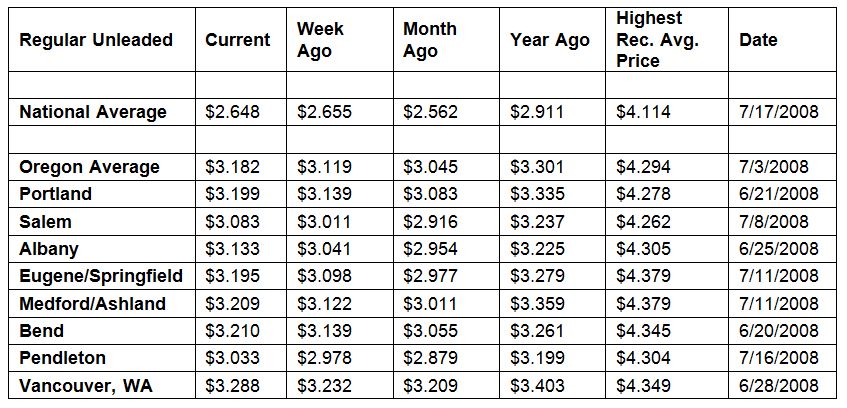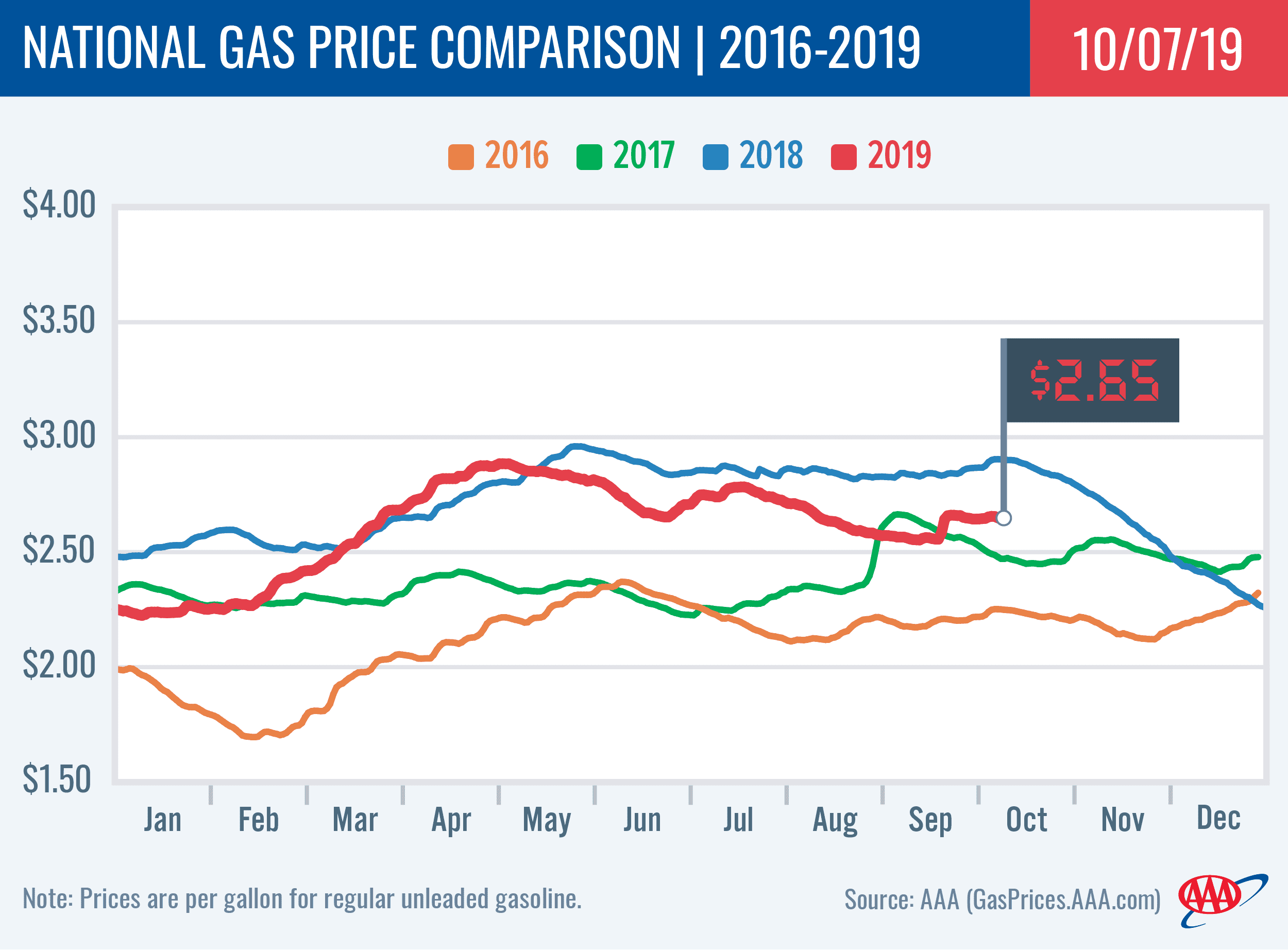PORTLAND, Ore., – Gas prices are holding steady or declining in most states, except for the West Coast region where prices are spiking after several unplanned refinery outages. For the week, the national average for regular slips half a cent to $2.65 a gallon. The Oregon average jumps six cents to $3.18.
“Significant price jumps in California are pushing prices higher for drivers across the West Coast, as gasoline stocks tighten in the region after disruptions at about five refineries in California,” says Marie Dodds, public affairs director for AAA Oregon/Idaho. “All regions are seeing planned and unplanned refinery maintenance, but it’s only the West Coast that’s really seeing gasoline stocks shrink and pump prices rise. In fact, most states saw gas prices drop by at least a nickel a gallon in the last week.”
California continues to be dramatically impacted. For the second week in a row, California is the only state in the nation to have an average above $4 a gallon, with a current average of $4.19. This is the highest average in California since May 12, 2014. This week California had a week-over-week jump of 12 cents, following the previous week’s gain of 32 cents.
Oregon is one of only seven states where prices are higher now than a week ago. The biggest weekly jump in the nation is in Nevada (+13 cents). California (+11 cents) has the second-largest jump, and Oregon (+6 cents) is third. Delaware (-8 cents) has the largest week-over-week drop. Prices are flat in Idaho and Arizona. This week there are five states with an average above $3 a gallon, same as a week ago.
Oregon is one of 35 states and the District of Columbia with higher prices now than a month ago. The national average is nine cents more and the Oregon average is 14 cents more than a month ago. This is the 4th-largest monthly increase in the nation. California (+55 cents) has the largest month-over-month increase. Connecticut (-4 cents) has the largest month-over-month decline. Alaska’s average is flat.
Oregon is one of 47 states and the District of Columbia where drivers are paying less than a year ago. The national average is 26 cents less and the Oregon average is 12 cents less than a year ago. Iowa (-44 cents) has the largest year-over-year drop. California (+38 cents), Nevada (+16 cents) and Arizona (+3/10 cent) are the only states with year-over-year increases.
West Coast
The West Coast continues to have the highest pump prices in the nation with all of the region’s states landing on the top 10 most expensive list. Tight supplies caused by refinery outages in the region are causing prices to spike.
| Rank | Region | Price on 10/8/19 | |
| 1 | California | $4.19 | |
| 2 | Hawaii | $3.67 | |
| 3 | Nevada | $3.43 | |
| 4 | Washington | $3.29 | |
| 5 | Oregon | $3.18 | |
| 6 | Alaska | $2.99 | |
| 7 | Arizona | $2.92 | |
| 8 | Utah | $2.78 | |
| 9 | Idaho | $2.76 | |
| 10 | Pennsylvania | $2.75 |
California is most expensive for the third week in a row, with Hawaii, Nevada, Washington, Oregon, Alaska and Arizona rounding out the top seven. Oregon is fifth most expensive for the 12th week in a row.
As mentioned above, Nevada (+13 cents) California (+11 cents), and Oregon (+6 cents) have the largest weekly jumps in the nation.
It appears operations are resuming at the five refineries in California that experienced outages. Assuming no additional outages, pump prices should stabilize toward the end of the week.
The U.S. Energy Information Administration’s (EIA) report, for the week ending on September 27, showed that total West Coast gasoline stocks decreased slightly from 27.1 million bbl to 27 million bbl. This level is approximately 900,000 bbl lower than this same time last year. Tighter supplies have caused prices to spike, but as refineries resume normal gasoline production levels, pump prices are expected to stabilize.
Oil market dynamics
Crude prices ended lower last week after continued trade tensions between the U.S. and China worried market observers. Those fears grew last week after the World Trade Organization ruled that the U.S. could impose tariffs on goods from the European Union. Increased tariffs could reduce global crude demand, helping to push prices down even further while crude supplies continue to increase. Moving into this week, further trade tensions could reduce crude prices amid worries that global crude demand will decline.
In related news, in its latest weekly report, EIA’s data revealed that total domestic crude inventories grew by 3.1 million bbl. At 422.6 million bbl, crude stocks are 18.7 million bbl higher than where they were at this time last year.
At the close of Friday’s formal trading session on the NYMEX, WTI increased by 36 cents to settle at $52.81. At the close of Monday’s formal trading session on the NYMEX, WTI fell 6 cents to close at $52.75. Today crude is trading around $52, compared to $53 a week ago. Crude prices are down about 10 percent in the last month and are about $21 per barrel less than a year ago.
Drivers can find current gas prices along their route with the free AAA Mobile app for iPhone, iPad and Android. The app can also be used to map a route, find discounts, book a hotel and access AAA roadside assistance. Learn more at AAA.com/mobile.
Diesel
For the week, the national average slips a penny to $3.00 a gallon. Oregon’s average adds a penny to $3.17. A year ago the national average for diesel was $3.28 and the Oregon average was $3.41.
Find current fuel prices at GasPrices.AAA.com.
AAA news releases, high resolution images, broadcast-quality video, fact sheets and podcasts are available on the AAA NewsRoom at NewsRoom.AAA.com.
Find local news releases at https://www.oregon.aaa.com/category/news-releases/
Fuel prices are updated daily at AAA’s Daily Fuel Gauge at AAA Gas Prices. For more info go www.AAA.com. AAA Oregon/Idaho provides more than 820,000 members with travel, insurance, financial and automotive-related services, and is an affiliate of AAA National, serving more than 60 million motorists in North America.



